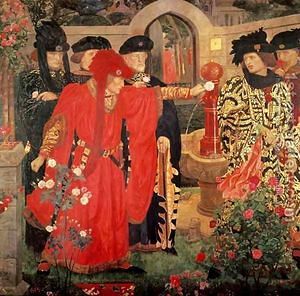Family Tree Research and the Wars of the Roses
There is one period of English history which is particularly fascinating for family tree research and that is the Wars of the Roses because of the competing claims to the English throne and how they came about.
The Wars of the Roses (there were a number of battles, hence the plural term) took place in the 15th Century 1455 to 1485 and they involved the House of Lancaster and the House of York. Both had the rose as an emblem – with the House of Lancaster represented as a red rose and the House of York as a white one. Both sides claimed the right to the throne, as both sides were direct descendants from King Edward III.
Edward III had a number of sons. His third surviving son John of Gaunt, the 1st Duke of Lancaster, was a very wealthy landowner and influential figure. He’d been married three times and his first marriage produced Henry IV and subsequently Henry V and Henry VI (the House of Lancaster).
Third Marriage
John of Gaunt’s third marriage to his long-term mistress Kathryn Swynford produced three sons and a daughter – the Beauforts. Daughter Joan Beaufort, the Countess of Westmorland, was the grandmother of Edward IV and Richard III – the House of York, whose claim to the throne came from Edmund of Langley, fourth son of Edward III and the Duke of York.
Richard II (1377-1399) is blamed for the War of the Roses in Shakespeare’s play. He was disposed by his cousin Henry, Earl of Derby who went on to become Henry IV and his [Richard’s] misrule therefore set a precedent where bad kings could be disposed by those who also had claims to the throne through their ancestry.
Henry VI had surrounded himself with unpopular nobles, he went through episodes of mental instability and many of England’s powerful lords had their own private armies. That, together with the Yorkist descendancy from Edward III, were the causes of the Wars of the Roses.
Army Defeated

Henry VI was a weak king and Richard Duke of York’s army defeated the King’s army at St Albans on 22 May 1455. Henry VI was taken prisoner and the Duke of York made protector of England. However, Henry VI retook the throne and after further battles, Richard was killed at the Battle of Wakefield in 1460.
His son, Edward, defeated the King’s army in 1461 and made himself king (Edward IV). Henry re-took his throne in 1470 but lost it again in 1471 after the Battle of Tewkesbury which also saw the death of Henry VI’s heir, Edward Prince of Wales.
As there were no other Lancastrians of age to challenge him, Edward remained king until his death in 1483. He had left behind two sons, Edward and Richard, both of whom were too young to have ruled the throne. The two were taken into the Tower of London where they both mysteriously disappeared – the skeletons of two young bodies turned up two centuries later, but they were never proven to be Edward and Richard.
Princes’ Death
The death of the princes in the Tower is largely attributed to Edward IV’s brother Richard III who, having postponed his nephew’s coronation, then had both boys declared illegitimate – therefore making himself the true heir to the throne.
Richard III’s reign, however, only lasted until 1485 when he was killed at the Battle of Bosworth and Henry VII took the throne. His claim to the throne came through the Lancastrian side – his mother Margaret Beaufort was the great-grand-daughter of John of Gaunt. His grandfather had been Owen Tudor who had married the widow of Henry V, Katherine of Valois.
The Battle of Bosworth marked the end of the Wars of the Roses and the establishment of the Tudor reign.
The Wars of the Roses are an interesting demonstration of the complexities of genealogy and descent. Did the rightful heirs win in the end? What do you think?
